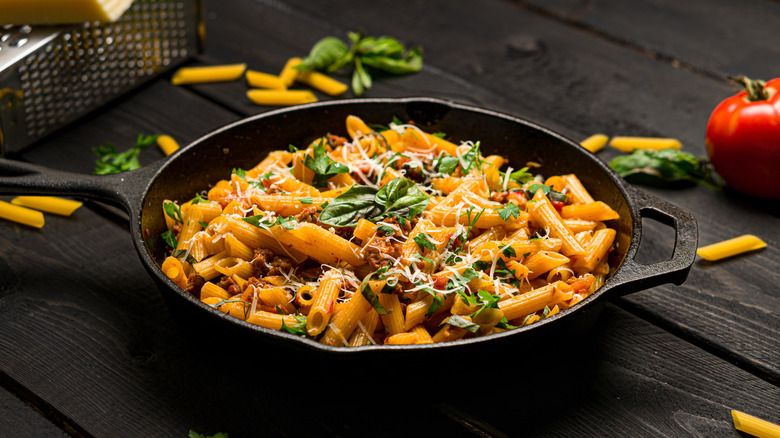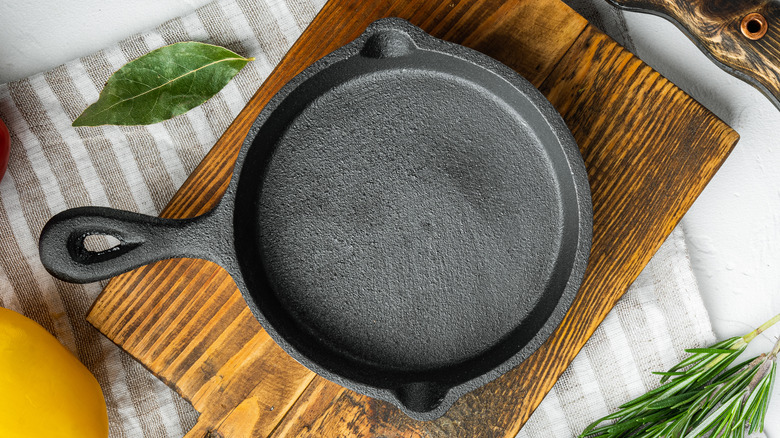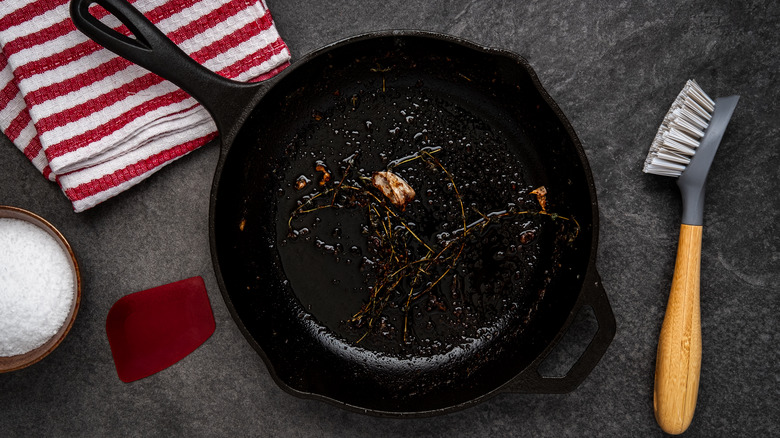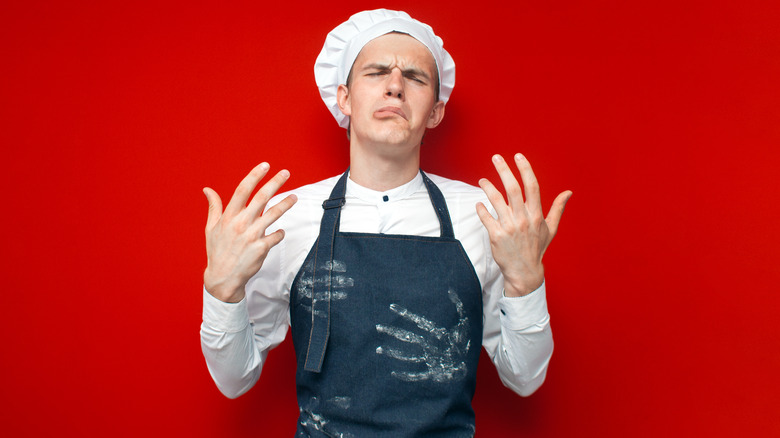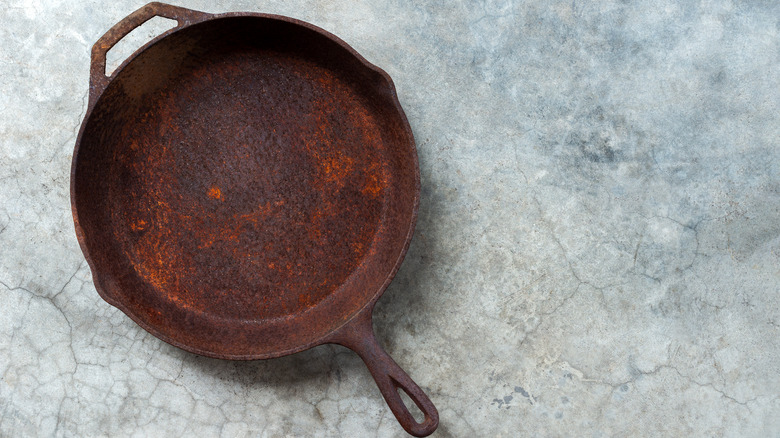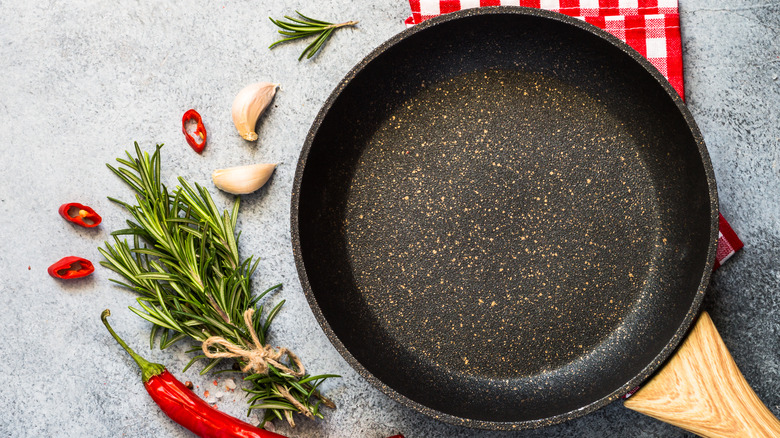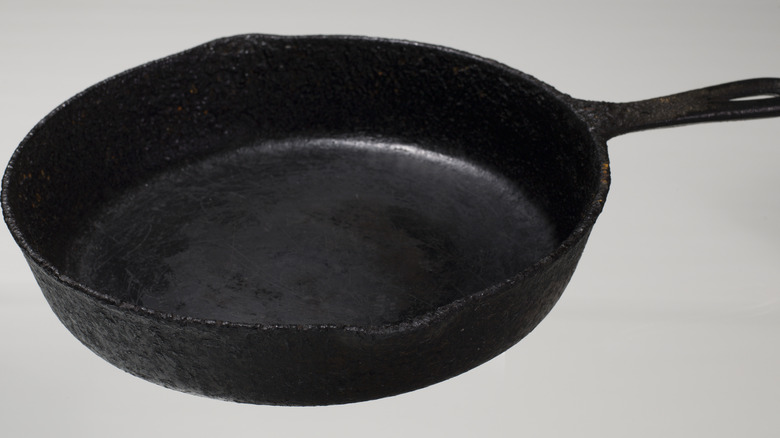Throw Your Cast Iron Pan Away Immediately If You Notice This
If you've been cooking a lot lately, you're not alone. As per Food Dive, the pandemic has made people happier to stay at home and cook a meal themselves, with 71% saying they will continue to do so long after restaurant restrictions.
Whether this was you before the pandemic or not, chances are, your cookware is important — as is its care, whether its your electric mixer or your beloved set of knives you use almost every day. That being said, nothing could ever replace the most important part of your kitchen (besides your culinary genius, of course): your downright-majestic cast iron pan. If you've had your cast iron pan for years, you probably love it more than words can explain. It took you so long to season it correctly, and you could never bear to part with it. That being said, there are six key reasons you should trash or recycle your cast iron, as difficult as it may be to face.
It's time to throw your cast iron away if it has a wobbly base
First sign you should get rid of your cast iron pan actually has nothing to do with the inside of it, or the part that touches the food. If you find that your cast iron skillet has a wobbly, uneven base, it's done for good. It can actually be a health and safety concern.
Test this out by setting your cast iron on a flat surface like your kitchen counter. If your pan easily wobbles to each side and it cannot place all of its weight on the surface at one time, you must discard or recycle it. As per Sparkling Penny, there's nothing that can be done about a pan that rocks to each side, and this means your food will be cooked unevenly. This may cause parts of your meals to burn, and other parts to actually be undercooked, a possible health hazard that can lead to salmonella. Even more, a wobbly pan is likelier to spill over or fall, which can be dangerous when cooking with oil.
A crack in the pan might not bother you, but it's important to discard it
Cast iron skillet experts often tell us it doesn't matter if your pan just fell down 10 stories, or hasn't been washed in months — it works fine. One factor you should never ignore is simple: Does the pan have cracks?
Even one crack in your cast iron is enough to toss it, or to recycle it by exchanging it at a scrap metal dealer for cash, or even using it in your garden as a very unique plant pot (via Sparkling Penny). You might ask what the big deal is about your pan having a crack — if it's tiny, no harm done, right? A cracked pan means it is completely unusable. As explained by Taste of Home, even a "hairline" crack that's barely noticeable in the cast iron cookware is reason enough to replace it, because the crack will only grow as it continues to be heated up on the stove and cooled back down. Eventually it will break the pan in half. If this happens while you're cooking, this can of course become a very hazardous situation. Even more, cracks keep bacteria inside them, which leads to other possible issues, like food contamination.
If your pan suffered a fall and has a hole in it, it's time to replace it
Next: If your cast iron skillet has a hole in it, there's no use in keeping it any longer. While few people are likely to use a cast iron skillet that has a hole right in the center of the base, having a hole on the handle or edge is just as much of a reason to order a replacement as soon as possible.
First off, if you're debating buying a used cast iron pan that has a hole in it — don't do it. As per Taste of Home, this means the skillet was once used around heavy machinery or motor oil, not necessarily someone just cooking dinner at home. If your own pan has a hole in it, whether from a tragic fall or faulty engineering, it is a goner — there's no choice but to toss. According to Oven Spot, holes can happen from washing your cast iron too harshly or thoroughly, or even from using metal cooking utensils with it in a rough manner. Whatever the reason, using it may lead to iron chips falling into your cooking — a very dangerous occurrence you should avoid at all costs.
While slightly controversial, rusted cast iron should be tossed
Is rust a reason enough to toss your cast iron skillet, or is it actually fine to cook with? That depends on who you ask, but when your health is possibly at risk, it is advised to simply replace it sooner rather than later.
As examined by Fox News, there are people on both sides of the debate when it comes to cooking with rusty cast iron. The pro side says that you can simply fix your skillet by removing the rust from it, either with steel wool, sandpaper, or the special water-based electrolysis technique that is every bit as scientific as it sounds (via Sparkling Penny). While you can try making your pan new again, experts at the University of Illinois say consuming tiny bits of rust is unlikely to cause harm.
That being said, others disagree, saying that many pans are unsalvageable and it can be difficult to know if you got all the rust out if it. Plus, if you use your pan often, you will continue to consume quantities of rust each time. As toxicologist James H. Woods PhD explained to Fox, "I am not aware of any studies showing any significant health issues associated with eating food prepared in rusted cookware, but why take the risk? I'd buy new cookware."
Severely discolored cast iron means you should nix it
So what to do if your pan doesn't exactly look like it is rusted, but has changed color over time? You might think there's no way the change can be due to rust, especially because your pan has not been exposed to much humidity. In fact, you might think that discoloration is quite normal, especially in a piece of metal cookware you've had for years. Most discoloration is completely normal in cast iron. But since it is sometimes impossible to differentiate rust from discoloration, you might have a far more dangerous situation on your hands without realizing it.
Continuing to use a rusted pan (even if you think it's discolored instead) may put your health at risk in more ways than one. Rust sometimes varies in shade, so your cast iron pan may very well be covered in corrosion. Rust is hazardous because if consumed, it can lead to tetanus, but only if it has been around the bacteria Clostridium tetani (via Fox News). Since this is usually only found outside or around soil, you might not have an issue with tetanus per se, unless you have left your cast iron pan in the garage, or taken it outdoors. Rust can still be toxic if enough is ingested, especially if done so frequently for long periods of time.
You might want to forgo a pan that has drastically changed texture
You need to throw away your cast iron pan if you begin to notice extreme changes in the skillet's texture, especially if it seems to come out of nowhere. Even if concealed or not a red-orange color, a strange, rough texture can be a sign of corrosion and rust, possibilities that are dangerous to the body and should not be anywhere near cooking. Just because it doesn't look like rust doesn't mean it isn't, and you should probably toss or recycle your pan instead of risking your health. Even more, as per Oven Spot, the corrosion can flake off in large chunks and be potentially extremely toxic.
As per Viva Flavor, discoloration isn't always a reason to let go of your cast iron skillet, and can actually be a feature that adds character to your cookware. If it is indeed discoloration, it is probably due to getting tons of sunlight from your window, if you tend to leave it on the stove. This won't affect its effectiveness, and it will still cook evenly. That being said, you can never be too sure if it is rust, oxidation, or a simple, harmless change of shades. According to Kitchenoa, many people choose to nix their discolored cast iron pans because of an aesthetic preference, since they don't like how it looks anymore. While that choice is truly wasteful, being careful about ingesting rust makes perfect sense.
